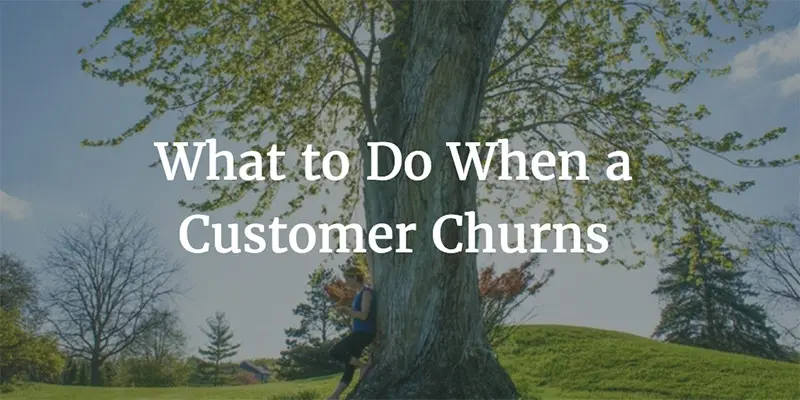Allison Pickens leads Customer Success at Gainsight. Thank you to Sonam Dabholkar, who leads one of our CSM teams, for contributing to this blog post!
Note to Gainsight Customers: This post contains links to Vault Assets you can import directly into Gainsight.
We are maniacal about Customer Success at Gainsight. And we expect this to result in an extremely high gross renewal rate.
Unfortunately, there are rare situations when our processes fail or the customer is subject to forces beyond our influence, and a customer churns. Yes, this has happened even at Gainsight!
Losing a customer is a very painful experience. It’s also a huge learning opportunity for everyone at our company.
The last time a customer churned, we followed a rigorous post-mortem process to investigate the root causes of why the customer churned and identify action items for each department at Gainsight. The goal? Ensure that the same situation never happens again. We never want to make the same mistake twice.
The CSM assigned to the churned customer scheduled a “Root Cause Analysis” meeting with the following Gainsight attendees:
- CEO
- Myself
- Customer Success: Team Leader, CSM, and Account Manager who was responsible for the renewal
- Onboarding Success: Team Leader, Project Manager, and Solutions Architect assigned to the customer during onboarding
- Technical Success: Team Leader and Technical Support Analyst that worked with the customer
- Sales: VP, Team Leader, and Account Executive that sold the deal
- Product: VP and relevant Product Directors
- Customer Success Operations
Before the meeting, the CS Team Leader worked with the CSM to prepare a short deck to guide the discussion. Then during the meeting, they shared the deck, guided the discussion, and captured notes and next steps.
Here was the agenda for the Root Cause Analysis meeting:
1. Customer Overview
We reviewed the summary section of the customer’s C360. We looked at their lifecycle stage, recent NPS, and overall health score. The goal was to get everyone at the meeting familiar with overall context to start.
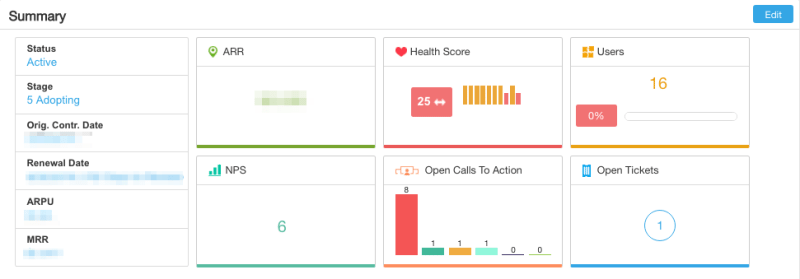
2. Customer’s Journey
We reviewed the customer’s C360 Milestones section in Gainsight, discussing major developments on their journey with us and identifying if there were any delays or gaps as compared to our healthy customers.
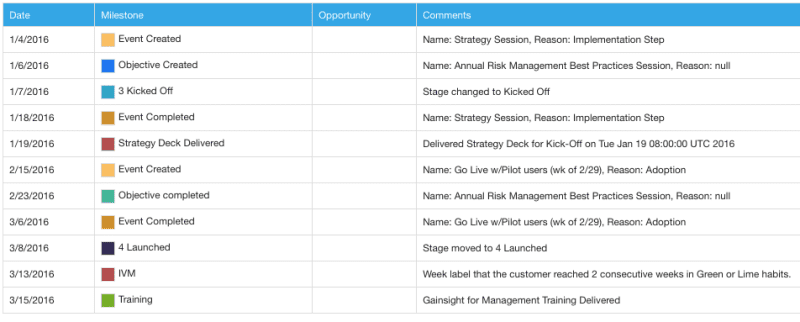
3. Key Metrics
We reviewed their adoption over time, as well as their NPS ratings and comments. This gave us more insight into the customer’s journey.
We discussed a chart on Healthy Level Users (HLUs – these users are in Cockpit every day) and Daily Active Users (DAUs) during the last 6 months:
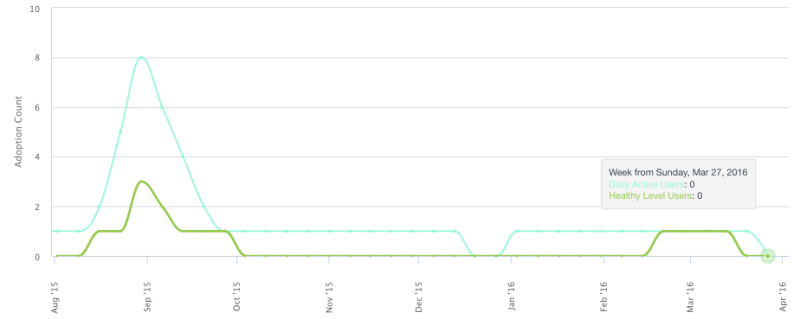
We also reviewed a chart on the usage of the top 10 users during the last 30 days:

Then we discussed their NPS ratings and comments:
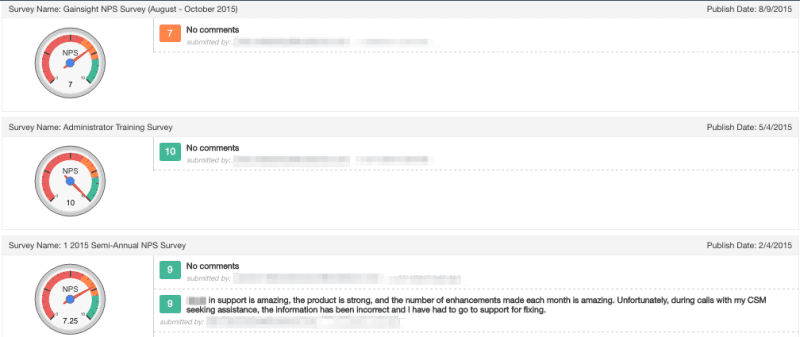
4. Risks
It was critical to identify the underlying reasons why the customer churned. It’s not enough to say “usage dropped after XYZ date” — WHY did usage drop? Was it preventable?
Our risk management framework shows a range of root causes for churn.
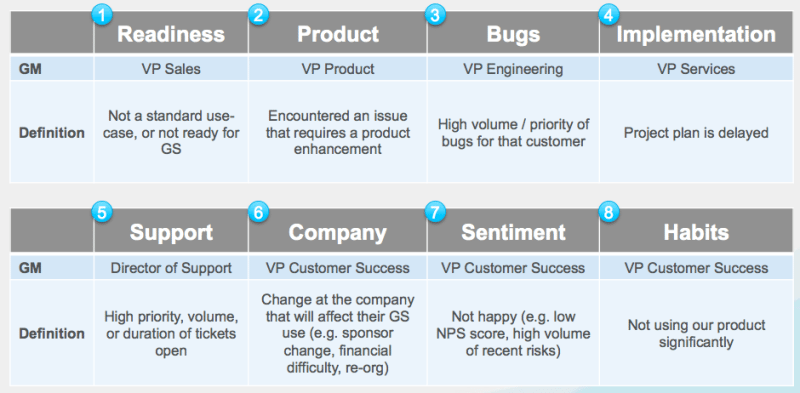
We had captured the presence of these risks in our relationship with the churned customer over time, using our Scorecard Measures. During the meeting, we reviewed those historical trends.

This data allowed us to figure out which of our risk processes broke down. From there, we pinpointed exactly where the breakage point was.
Note that the risk category itself doesn’t count as a root cause. The following are NOT examples of root causes:
- Launch Risk: The customer didn’t make it through onboarding
- Company Risk: Our executive sponsor left the company
- Product Risk: The customer felt the product didn’t meet their needs
- Other: The customer chose a competitor
These factors might have precipitated a risk, but the root cause lies in how you addressed that risk.
- Why did the customer choose a competitor? Was it because, for example, you weren’t responsive to their requests?
- Why did the departure of your exec sponsor precipitate the churn? Was it because, for example, you didn’t do a good job introducing the new sponsor to the product?
- Why did the customer feel the product didn’t meet their needs? Was it because, for example, they didn’t get proper training?
Keep asking yourself “why” until you arrive at a root cause that (1) points to a systemic problem that (2) is actionable.
5. Surprise or Not?
Given all the data that we track, and given our rigorous processes to follow up on the data, a churn should never be a surprise. If we’re doing our job, every churn should fall into one of two categories:
(1) We knew it was coming and did everything we could to prevent it, or
(2) We knew it was coming and decided the customer wasn’t the right fit for our product — and could never be successful no matter what we did. In this case, we probably shouldn’t have sold to this customer in the first place, and we’ll make sure our Sales team has a better process in place to avoid this (see below).
If you’ve conducted a root cause analysis for several churns and discovered that #2 applies in each case, then you may have a Product-Market Fit problem. Organize a discussion with your company’s leadership team to figure out how to address it. You might be targeting the wrong type of customer, or you might be targeting the right type of customer (e.g. a new market you want to enter) in the wrong way.
6. Action Items
Having identified the root causes, we asked, “what do we need to do to prevent a similar situation from happening ever, ever again?”
In particular, we discussed these specific questions:
- What CTAs should we add to detect this type of customer risk situation?
- What other CSM processes do we need to put in place?
- What Services offerings do we need to add?
- What Product changes do we need to make?
- What Sales qualification criteria should we add? What other processes can we institute to ensure that expectations are set properly in pre-sales?
Once we had our answers, each VP ensured that these were incorporated into their team’s initiatives for the quarter. Note that churn is a cross-functional problem; it’s the job of Customer Success to rally the company around the improvements required in order to prevent the churn.
After the meeting, we posted our learnings to the Chatter feed in Customer360 (which is our source of truth for notes on customers), so that our entire company learned why the churn occurred and the plays we’re pursuing as a result.
Bottom line: It’s important to drive to action rather than wallow in disappointment. Live, learn, and move forward.
And who knows? Perhaps the internal improvements you make as a result of the churn will help you win back the customer in the future!
Vault Assets mentioned in this post
(for Gainsight customers only)
Here are ready-to-use versions of what you’ve seen in this post:
If you’d like to learn more about how to implement these processes in your organization, check the Business Processes section of Gainsight Go, check out the Vault, pose a question on Community, or contact your CSM. Follow Allison’s blog posts on Twitter at @PickensAllison.
